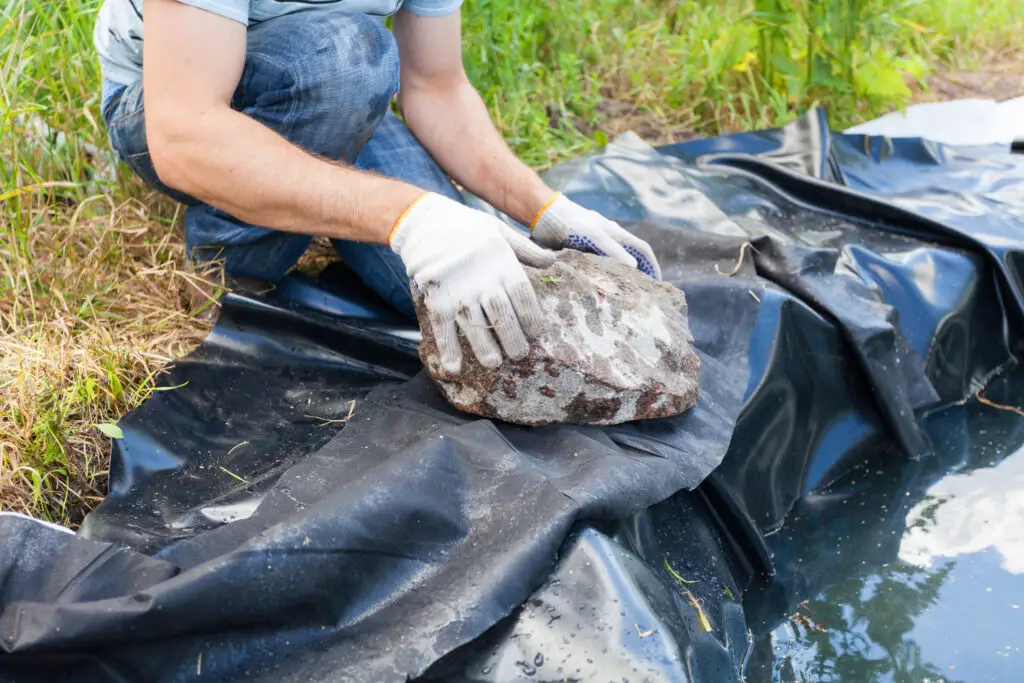
Koi will add a flash of shimmering color to your yard as well as a calming presence. The majority of your construction decisions, including the sort of liner you’ll require, will be determined by the shape of your pond. Whichever lining material you choose, it is vital to select a well-known brand with a good track record and warranty.
First, determine whether you want to make your ideal koi pond with a flexible liner or a hardshell premade liner shaped to a specified size. Second, choose from these types of Koi pond liners to create your Koi pond, ensuring it is fish and plant safe:
- EPDMHDPE
- LLDPE
- PVC
- RPE
- fPP
- Butyl
This blog post will talk about the advantages and disadvantages of each of the types mentioned above. Furthermore, we will learn about the difference between a hard shell and a flexible liner, if you need an underlayment, and how to gauge the thickness of a liner.
Pro Tip: If you’re tired of wasting money and making costly mistakes on the koi-keeping hobby or are thinking about buying koi fish but don’t know where to start, I strongly suggest you check out this ebook. I recently read this ebook, and it contains SO much useful information, such as:
- 3 proven steps to identify koi fish diseases
- WARNING: 3 things you should NEVER do when it comes to caring for koi
- When to seek professional help when it comes to looking after your koi
7 Types Of Koi Ponds Liners
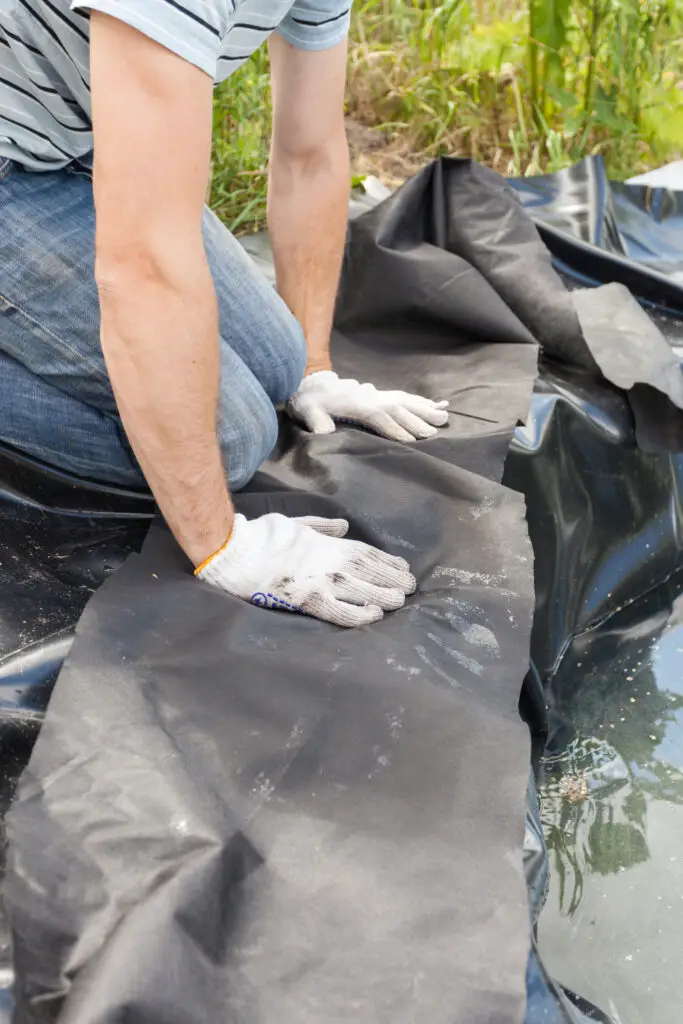
There is no perfect liner material, but all of the choices discussed here have benefits that could make them worthwhile choices when planning and building a Koi pond.
1. EPDM (Ethylene Propylene Diene Monomer), pond liner
Synthetic rubber and synthetic tire blends make up the base materials for the waterproofing membranes. To produce highly elastic waterproof materials, manufacturers add other chemicals like reinforcing agents, antioxidants, and softeners to curing agents.
When looking for an EPDM liner, ensure it’s safe for fish and plants. Unfortunately, some people try to save on costs and substitute pond liner for roofing liner material, which is flawed. These roof liners are frequently treated with chemicals to prevent algae or mold from growing, are toxic to fish, and are prone to tearing.
EPDM pond liners are more resistant to punctures and rips, and they are an excellent choice for ponds. You may find it challenging to move around while installing, especially if you have a large pond design with many features. Laying an underlayment is essential because the material is soft. We recommend the 45mil pond liner as a minimum.
The advantage of EPDM is that it is very soft and flexible and can reliably withstand very high and low-temperature fluctuations. They have a good UV, ozone, and weather resistance rating. They could last more than 20 years when installed correctly.
The disadvantage of EPDM is that it can’t be heat welded together; you will need adhesive tape. It is not chemical resistant, and it is heavier and more expensive than other lining materials.
2. HDPE (High-Density Polyethylene)
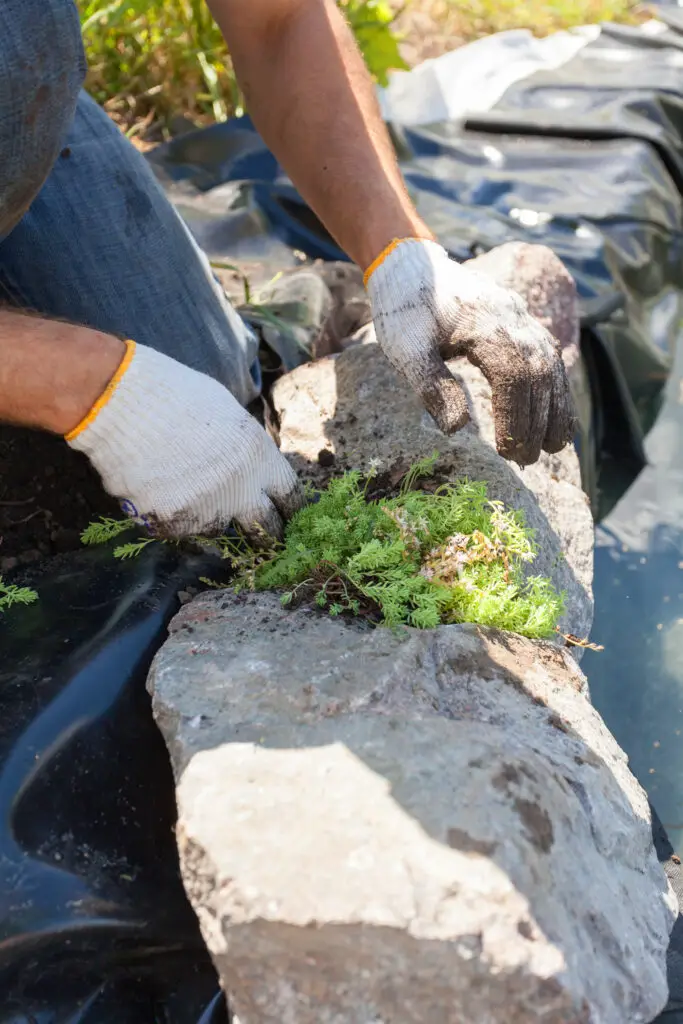
HDPE pond liners are robust and flexible semicrystalline plastic with excellent chemical and corrosion resistance. These liners are among the most long-lasting and robust polyethylene liners available and can be fusion welded together in the field to make a permanent seal. Fusion welding requires an expert welder and accompanying equipment to ensure a flawless installation.
Both fish and plants are safe in HDPE liners ponds. HDPE liners are among the most cost-effective and have one of the most extended service lives of any polyethylene liners.
The advantage of HDPE is that it has excellent chemical and cold temperature resistance. It has good UV resistance and is fish and plant safe. It is weldable and very durable, lasting upwards of 30 years. Great for large ponds with not a lot of added curves and shapes.
The disadvantage of HDPE is that it has poor flexibility and is prone to punctures and scratches. It is pretty heavy, cannot be custom fabricated, and must be welded on location. Very high temperatures cause this material to expand and cause stress cracking.
3. LLDPE (Linear Low-Density Polyethylene)
Since they don’t have a crystalline structure, LLDPE pond liners are more flexible than their HDPE counterpart. Although polyethylene (LLDPE) and high-density polyethylene (HDPE) liners have many plastic properties in common, they are very different in strength and application.
These liner kinds are pretty inexpensive, and both LLDPE and HDPE are weldable, harmless to fish and perform well at average pondwater temperatures. Yet, it’s also often used as liners meant to contain waste or hazardous substances.
Liners made of LLDPE are easier to install and mold around edges and tight cracks and crevices. Because of its flexibility, LLDPE liners can adhere to rugged terrain more precisely than HDPE liners, with fewer wrinkles. LLDPE is less prone to stress cracking than HDPE because of its softer nature.
The advantage of LLDPE is that it has flexible and easier to conform to the pond terrain. It has a relatively good UV and chemical resistance and is fish and plant safe. It is weldable and very durable, lasting upwards of 30 years. Great for smaller ponds with lots of added curves and shapes.
The disadvantage of LLDPE is that it has poor tensile strength and is prone to length-wise tears and permanent deformation stretches. Like HDPE, it is pretty heavy, cannot be custom fabricated, and must be welded on location. Very high temperatures cause this material to expand.
4. PVC (Polyvinyl Chloride)
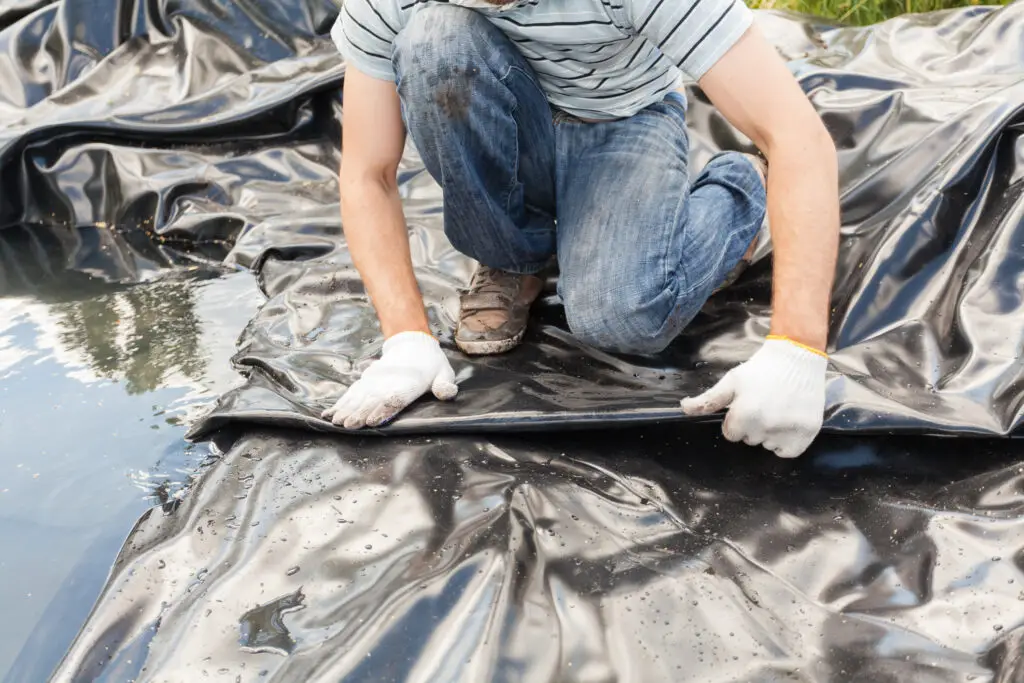
PVC pond liner is usually the most affordable option, and its properties are between RPE and EDPM regarding weight and puncture resistance. PVC is not a good choice for cold locations because the liner may crack along folds in the winter.
PVC isn’t inherently flexible, and the plasticizers and other additives used to make it so are frequently hazardous and may seep into pond water. They are less resistant to sunlight without it. If the liner is made expressly for ponds, it is safe for fish and plants.
The PVC pond liner is simple to set up and install, and underlayment is needed, which is simple for the average homeowner. PVC liners are also less resistant to ozone and UV light, which means they may degrade prematurely.
The advantage of PVC is that it is exceptionally foldable and flexible and can fit any rough surface with ease. It has excellent chemical resistance and is easy to seam and install. Custom fabrication can be done at a factory and then shipped to the homeowner. The average lifespan is between 10- 30 years.
The disadvantage of PVC is that it has a weak UV, Ozone, and weather resistance and degrades prematurely under extreme conditions. If not made explicitly for fish ponds, it may be toxic.
5. RPE (Reinforced Polyethylene)
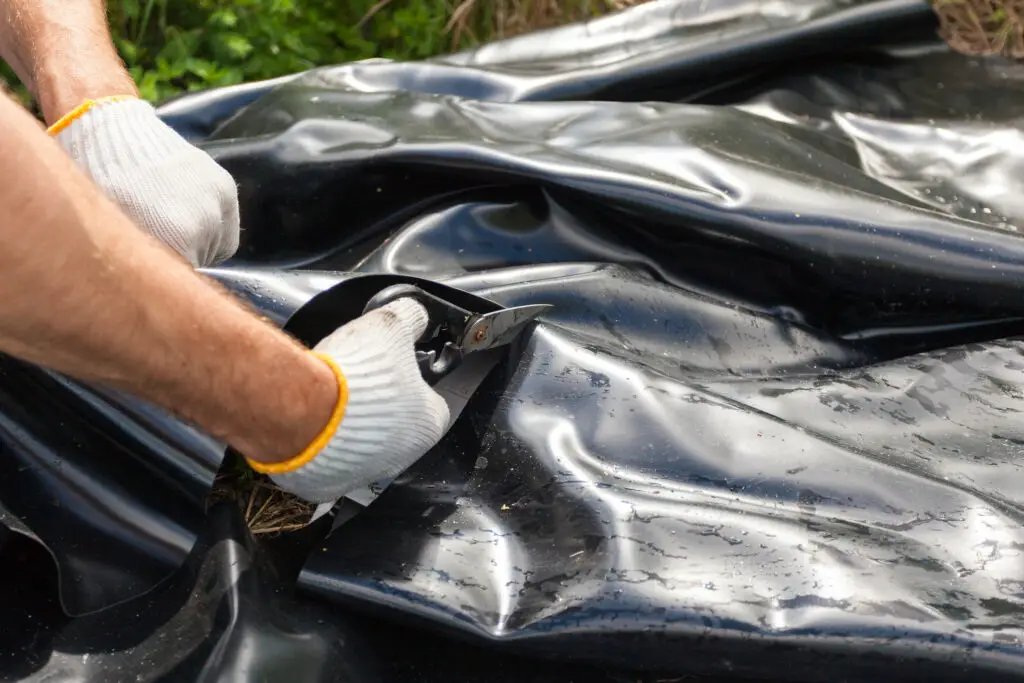
RPE offers nearly all of the advantages of HDPE and LLDPE while avoiding many of their drawbacks. RPE is one of the most durable liner materials available, and it’s undoubtedly more robust and more resistant to punctures than either LLDPE or HDPE, even though they’re all comprised of the same plastic polymers.
One of the main reasons people pick RPE over other pond liners is its size and weight.
RPE liners are lighter and thinner than other flexible liners, but they are also more durable. Underlayment is often required with different types of flexible pond liners because these liners don’t have much puncture resistance against things like stones, tree roots, or sharp edges.
The advantage of RPE is that it is incredibly durable because they are reinforced, making them strong and puncture-resistant. They are thinner and lighter than other liners making them easy to apply. Heat welding capability is also one of the advantages of using RPE.
The disadvantage of RPE is that it is a bit more expensive than other liners, and being a recently young invention makes it difficult to predict how long it will last.
6. FPP (Flexible Polyethylene)
fPP Geomembrane liner protects against punctures and is unaffected by UV, ozone, or soil microorganisms. fPP has Outstanding tensile strength and excellent chemical and environmental resistance. Furthermore, because the seams can be heat-welded, these fPP Geomembranes may be prefabricated and assembled in the factory.
There is no need for plasticizers to make these liners flexible. They are innately flexible and can conform to various pond shapes with irregular surfaces.
The advantage of FPP is that it is incredibly flexible and foldable and can conform to rougher and uneven terrain. They’re ideal for creative ponds with a focus on shapes and details. They stay flexible in freezing water, have a nearly 30-year lifespan, and are UV resistant; they are well worth trying.
The disadvantage of FPP is that it is vulnerable to hydrocarbons like chlorine-containing chemicals, animal fat, and some oils. Stress cracking and oxidative damage may also occur.
7. Butyl (Synthetic Rubber)
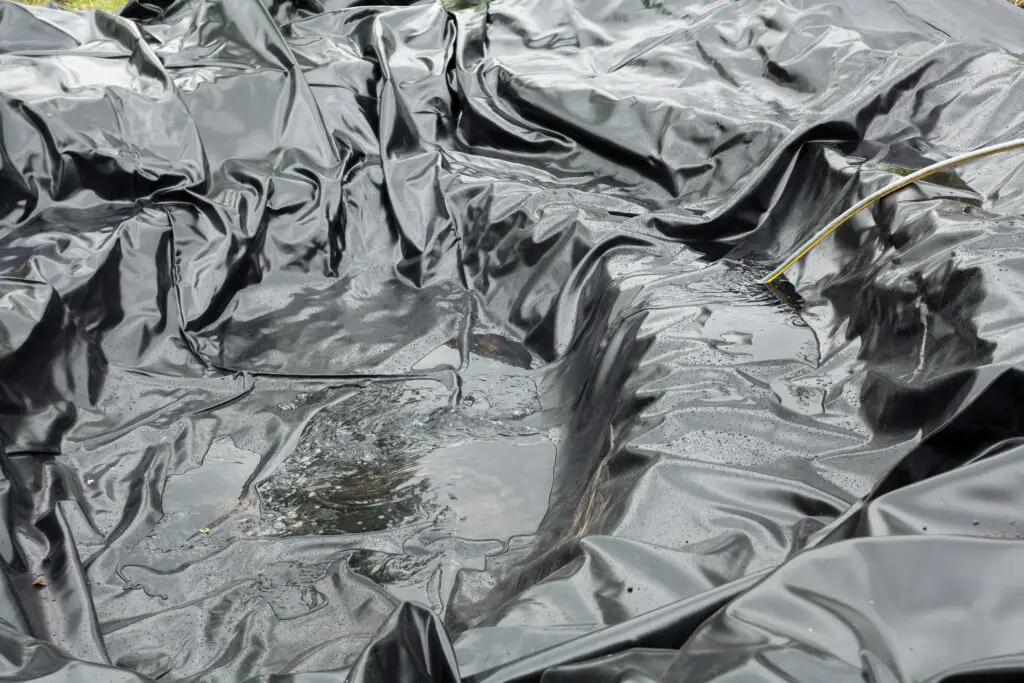
Butyl rubber was first produced in the United States by Standard Oil (ExxonMobil) in 1937. This non-natural rubber was one of the oldest forms of plastic liners until the creation of EPDM. The waterproof and gas-tight features, with a working temperature range of -45°C to +130°C, made it ideal for many ponds and water applications. It is also highly resistant to sunlight and ozone.
Butyl is similar to EPDM in terms of chemical resistance. Although EPDM is stronger than Butyl, Butyl is one of the most cost-effective liners compared to EPDM, making it a popular choice among pond builders on a budget.
The advantage of Butyl is that it is very flexible and easy to apply to various surfaces. With a good UV, ozone, and extreme weather resistance, it is a good choice for many who need a cheaper alternative to EPDM. There are claims that Butyl liners lasted almost 50 years.
The disadvantage of Butyl is that it has poor chemical resistance, and you cant seam weld two pieces together without specific adhesives that may leach into the pond. It is pretty susceptible to punctures and tears, and without an underlayment to protect it, you will have lots of leaks.
Related posts:
Top Pond Liners Brands To Choose From
- TotalPond
- Aquanique
- Firestone
- Aquascape
- Algreen Avonlea
- Maccourt hard shell pond liner
- Lifeguard pond liner
If you want to learn more about the best pond liners for koi ponds, you can click here to read my blog post: The 10 Best Thick Pond Liners.
Lining Your Pond With A Flexible Liner Vs A Hard Shell Liner

When planning your pond, it is good to consider whether you want a soft, flexible liner or a hard shell-preformed koi pond. To make sure your Koi fish have enough movement and remain healthy, you should prioritize the size of your pond, designing one that is as close to the required proportions as feasible. Koi fish need a large space, so you might want to start with a smaller pond to save money.
Additionally, while Koi fish are durable and easy to care for, they require special consideration and care when designing your pond. Remember that the koi fish’s comfort and the pond’s long-term viability are the most important factors to consider. To accommodate your growing collection, you may need to build a bigger koi pond in the future.
When considering a smaller pond to save money, starting with a hard shell pond might be better. They are easy to install, and you will know the exact shape of the pond when buying it. The only downside to this type is the limitations in available designs, and they are not feasible for large numbers of Koi.
Flexible liner ponds require more planning and will cost more depending on the thickness of the liner and if you are adding an underlayment. Imagine your ideal koi pond shape, and there are no limits to the design features and concepts you may add. It’s simple to add to an existing pond when expanding your Koi school. These are some of the advantages of a pond with a flexible liner.
Should You Use A Geotextile Underlayment?

Unstable soil conditions are the leading cause of Koi pond and waterfall failures. Non-woven geotextile materials are ideal for soil stabilization, preventing rocks and roots from penetrating the pond liner and providing padding between stones and boulders when put on top of the liner or in the pond. The non-woven material is made entirely of polypropylene and is resistant to fading from ultraviolet radiation.
This pond underlayment is a soft cloth that allows gas to escape while also protecting your liner from sharp items and is simple to install. These cloths resist insects and rodents and will not decay or develop mildew. Underlayment sizes come in 5-inch, 10-inch, and 15-inch widths, and to install the pond liner, lay the pieces next to each other. Cut fabric pads from additional underlayment to pad large rocks and boulders placed inside your koi pond.
When adding water to the pond, pressure builds in all directions causing the rubber pond liner to stretch to fit the shape of the hole you put it in. Installing a pond underlayment will prevent the liner from expanding, moving, or weakening since the non-woven material does not stretch. Without underlayment protection, laying it bare is a significant risk to the liner’s long-term durability.
If you want to know more about the underlayment beneath a pond liner, I recently wrote a blog post about whether pond underlayment is always necessary, the benefits of underlayment, what material underlayment is made from, how the underlayment is installed, and how long it will last. Click here to read my blog post: What Do You Put Under A Pond Liner?
What Is The Correct Liner Thickness For Your Pond?

In general, the thickness of any liner, including pond liners, is measured in mils. Even though mils sound like the thickness measurement in millimeters, a mil is a percentage of an inch. It’s amusing to read how many individuals try to correct others, claiming that a 45 mil thick liner would be 1.77 inches thick.
The general thicknesses you will encounter when comparing pond liners are:
- 20 mils = 0.02 inches or 0.5mm
- 30 mils = 0.03 inches or 0.7mm
- 45 mils = 0.045 inches or 1.14
- 60 mils = 0.06 inches or 1.5mm
- 80 mils = 0.8 inches or 2.0mm
After you’ve learned how to compare mils, you’ll need to figure out how thick of a liner you’ll need for your pond project. Depending on the pond location, surface type, and how many rocks and tree roots are under the pond, determine the thickness you need. Thicker liners are less flexible, heavier, and more challenging to form, but they are more tear-resistant and last longer.
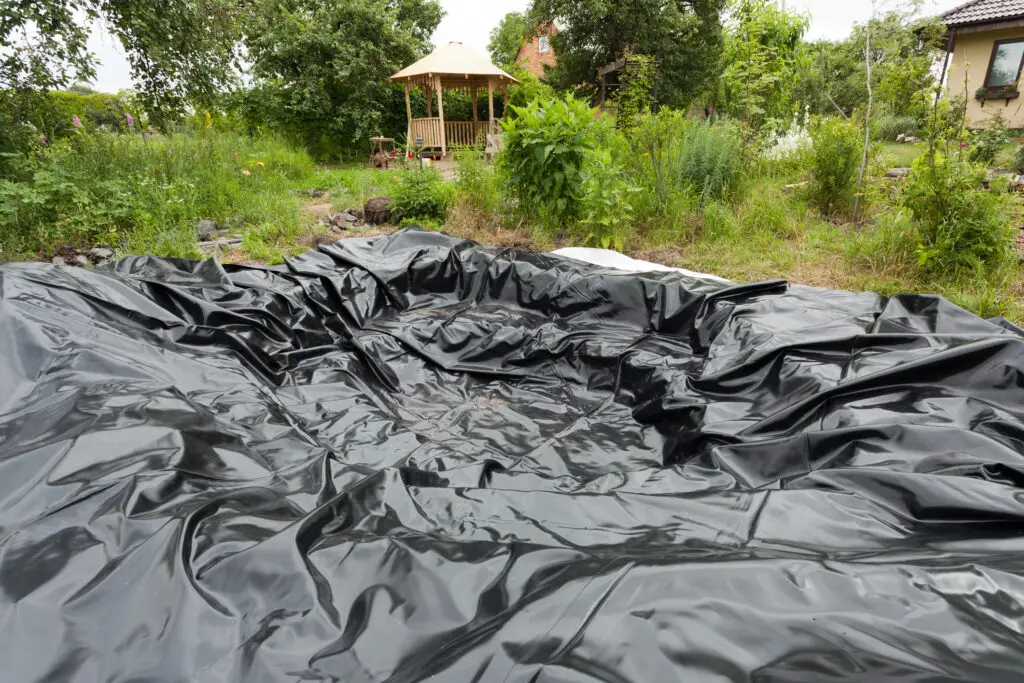
Conclusion
Consider the size of the pond, how many fish will be placed in it, whether you will need to expand in the future, and what type of weather fluctuations you will encounter in your location. These are factors to consider when planning the building of your koi pond. These considerations will help you determine the type of material that will best meet your needs for the shape and atmosphere you desire.
Related Blog Posts
- The Best 10 Thick Pond Liners
- What Color Pond Liner Is Best?
- 9 Pond Liner Alternatives For Your Koi Pond (Plus 4 Homemade Pond Liner Ideas)
- What Do You Put Under A Pond Liner?
- How Do You Line A Koi Pond?
- What Should I Put On The Bottom Of My Koi Pond?
- The Best Colors For Fish Ponds
- How To Build A Small Koi Pond

